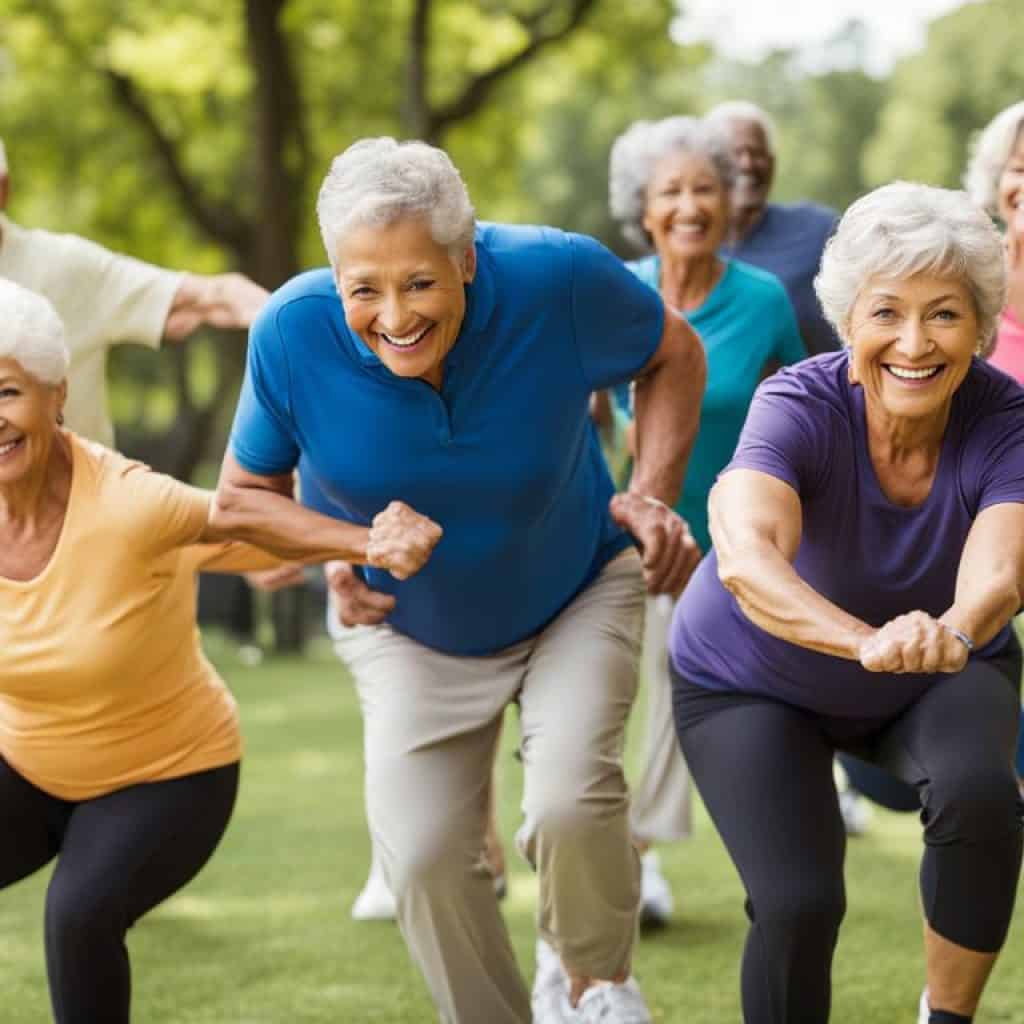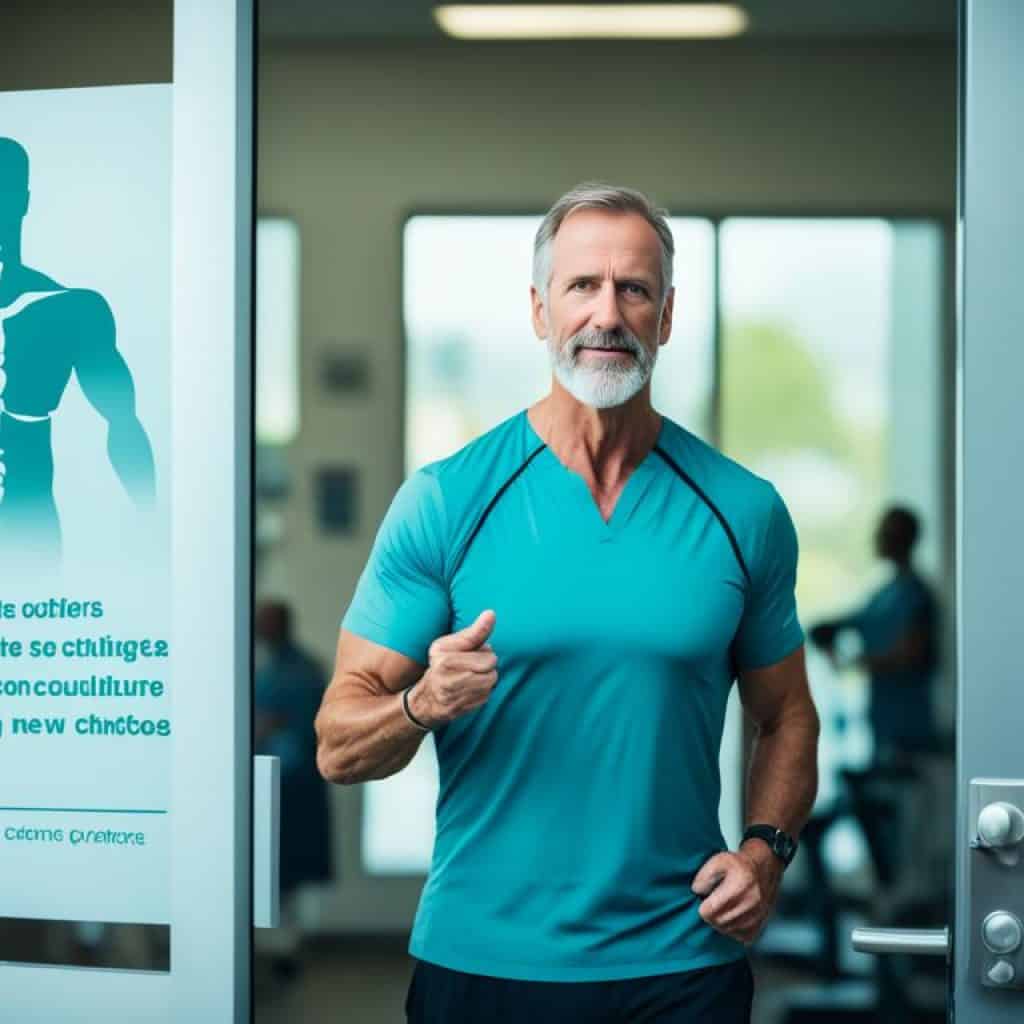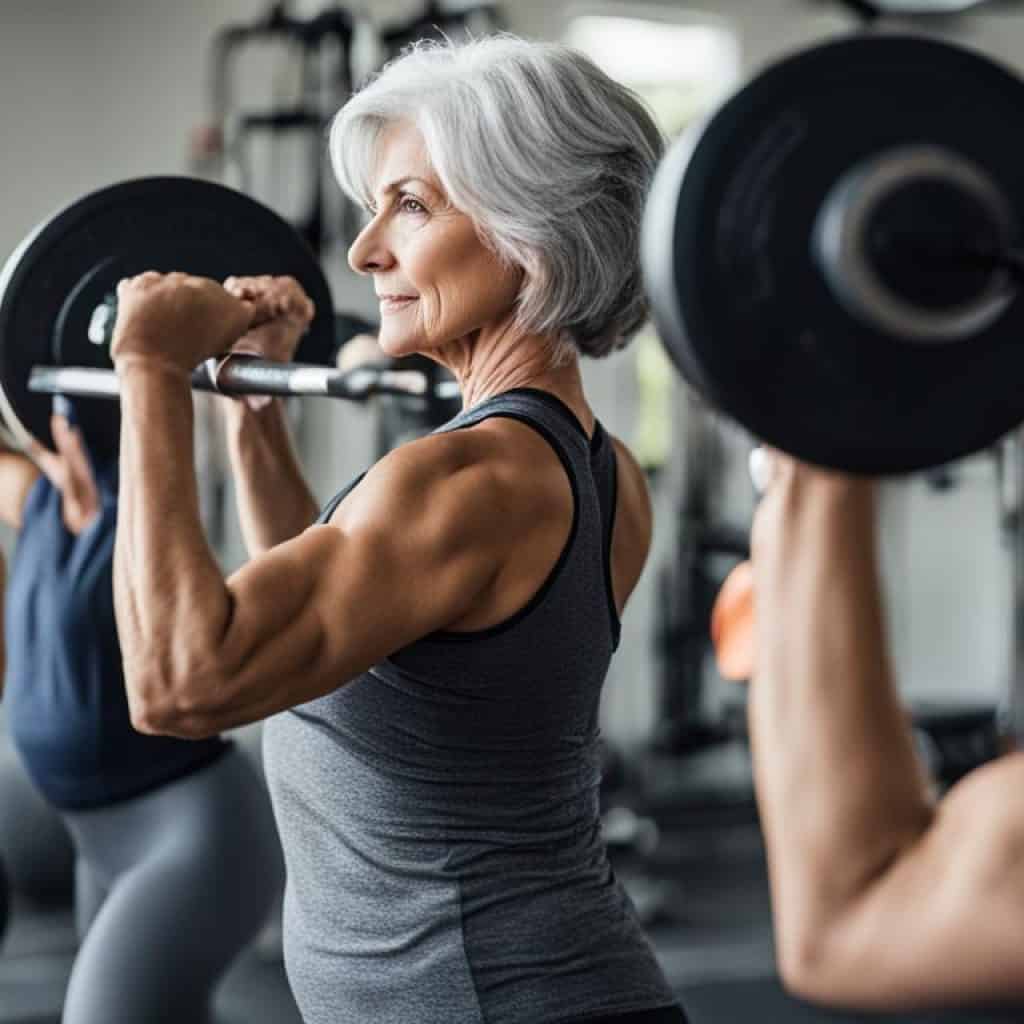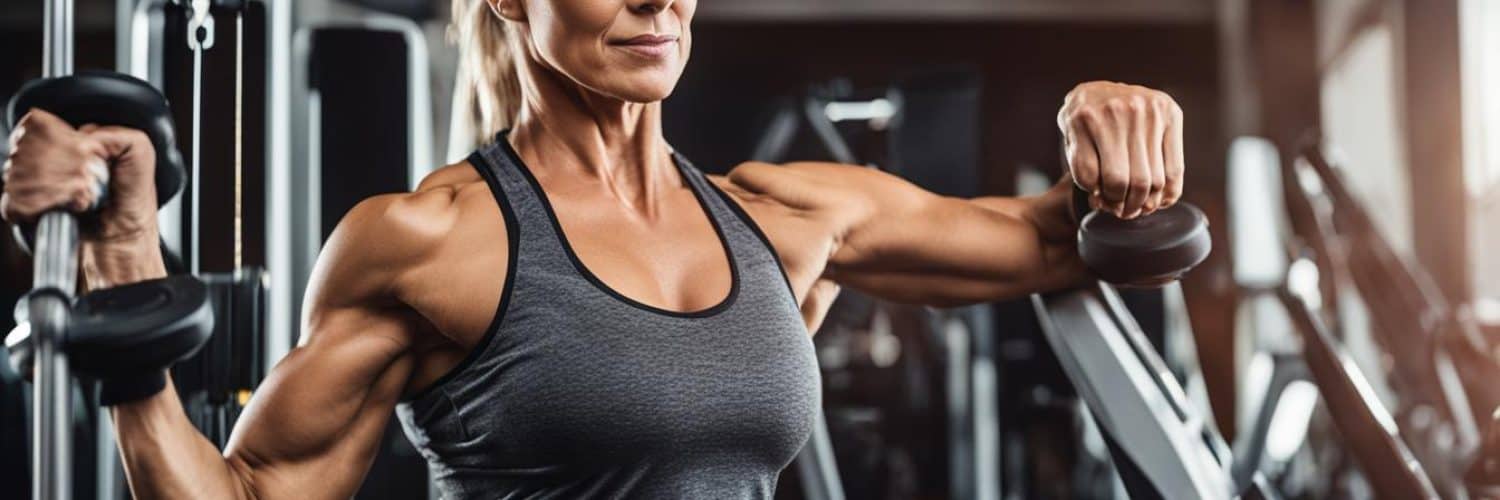As the years go by, our bodies may change, but our spirit remains youthful and eager to explore new possibilities. Aging is a natural process, but it doesn’t mean we have to slow down or settle for a sedentary lifestyle. In fact, staying active and maintaining our fitness becomes even more important as we enter the second half of our lives.
Every journey begins with a single step, and embarking on a fitness journey after 50 is no different. It’s a personal odyssey of self-discovery, resilience, and embracing the belief that age is just a number. It’s about reclaiming our vitality, defying stereotypes, and proving to the world that we can be “50 And Fit.”
Through this article, we invite you to join us on this empowering journey of healthy aging and staying active after 50. We’ll provide you with expert tips, motivational stories, and actionable advice to help you maintain a vibrant lifestyle and achieve your fitness goals.
Key Takeaways:
- Stay active and maintain your fitness as you age
- Find exercises that you genuinely enjoy and stick to them
- Gradually build up your exercise routine to avoid overexertion
- Exercise with friends for encouragement and motivation
- Make exercise a priority in your schedule
Find an Exercise You Love and Stick to It
Staying active after 50 is all about finding an exercise or physical activity that brings you joy. Whether it’s brisk walking, swimming, cycling, gentle yoga, or even dancing, engaging in activities you love increases the chances of sticking with them in the long run. The key to maintaining a healthy lifestyle after 50 is to find an exercise routine that you genuinely enjoy and that suits your abilities and preferences.
Not sure which fitness activity is right for you? Take our quiz to discover the exercise that aligns with your interests and goals. This personalized assessment will help you identify a fitness routine that brings you happiness while improving your physical well-being.
“I struggled to find an exercise routine that I enjoyed and could stick to, but once I discovered swimming, everything changed. It became my sanctuary, allowing me to detach from the stresses of life while keeping my body active and fit.”
– Sarah, 55
Everyone’s exercise journey is unique, and the stories of individuals who have found joy and fitness after 50 can be truly inspiring. Read real-life accounts of people who have discovered their passion for exercise and how it has positively transformed their lives. These stories will encourage you to embark on your fitness journey and remind you that it’s never too late to prioritize your health and well-being.
Gradually Build Up Your Exercise Routine
When it comes to maintaining fitness in middle age and beyond, the key is to start slowly and build up gradually. Pushing yourself too hard right from the beginning can lead to injuries and demotivation. The good news is that our bodies are adaptable, and with consistent effort, you can achieve remarkable fitness goals as an older adult.
The British Heart Foundation’s Physical Activity Specialist has designed a 10-minute workout specifically catered to individuals over 50. This workout takes into account your current fitness level and age, ensuring a safe and effective routine to kickstart your fitness journey.
“Gradual improvement is the key to success. Start small and celebrate each milestone along the way. You’ll be amazed at what you can achieve!” – Jane, 55
Don’t be discouraged if you’re starting from scratch or have been inactive for a while. It’s never too late to make a positive change in your life. Our success stories from individuals who have gradually increased their activity levels prove that it’s possible to achieve incredible fitness transformations after the age of 50.
| Name | Age | Achievement |
|---|---|---|
| Mary | 60 | Ran her first half marathon |
| David | 53 | Lost 50 pounds and regained his energy |
| Elizabeth | 62 | Completed a 100-mile bike ride for charity |
By taking small steps, setting achievable goals, and sticking with your exercise routine, you can gradually improve your fitness, boost your energy levels, and enhance your overall well-being. Remember, the journey to maintaining fitness after 50 is a marathon, not a sprint.
Exercise with Friends for Encouragement
Exercising with friends or joining groups can be a game-changer when it comes to staying active and motivated. Not only does it provide a sense of camaraderie and support, but it also adds an element of fun to your fitness routine.
Finding enjoyable activities to do with friends can make exercise feel more like a social gathering rather than a chore. One surprising and exciting option is walking rugby, where you can combine the joy of walking with the exhilaration of a sports game. It’s a great way to stay active, have a good time, and bond with your friends.
Joining a walking group is another fantastic way to ensure you get regular exercise and maintain a healthy lifestyle. Walking groups offer the opportunity to meet new people, share experiences, and inspire one another to reach your fitness goals. Whether you choose a local park, a nature trail, or an urban setting, walking with a group of like-minded individuals can make a significant difference in your fitness journey.
Walking groups also provide a supportive environment where you can encourage each other, share fitness tips, and celebrate your achievements. You’ll find that the power of collective motivation can help you stay committed to your workout routine and overcome any hurdles along the way.
“Walking with a group adds a layer of camaraderie that makes exercise enjoyable and rewarding. The shared experiences and support from friends can make all the difference in staying active and achieving your fitness goals.” – Name
| Benefits of Exercising with Friends |
|---|
| 1. Encouragement and motivation |
| 2. Social interaction and connection |
| 3. Fun and enjoyment |
| 4. Increased accountability |
| 5. Healthy competition |
So, grab a friend or join a group to make exercise a social and uplifting experience. Your fitness journey will be more enjoyable, and you’ll create lasting memories along the way.

Stay motivated and have fun!
Make Exercise a Priority in Your Schedule
Staying active after 50 is all about finding the time and making exercise a priority in your daily schedule. By carving out dedicated time for physical activity, you can ensure that fitness remains a central focus in your life. Here are some valuable tips to help you incorporate exercise into your busy routine:
- Create a Schedule: Plan your workouts ahead of time and add them to your calendar. Treat exercise as non-negotiable, just like any other important appointment.
- Set Realistic Goals: Start small and gradually increase the duration and intensity of your workouts. Setting achievable fitness goals will keep you motivated and give you a sense of accomplishment as you progress.
- Mix It Up: Find a variety of exercises that you enjoy. This will make your workouts more engaging and prevent boredom. Consider trying different activities such as walking, swimming, tai chi, or yoga to keep things interesting.
- Find Accountability: Team up with a workout buddy or join a fitness class to hold yourself accountable. Having someone to exercise with can provide motivation, support, and make exercising more enjoyable.
- Make Everyday Activities Count: Look for opportunities to be active throughout your day. Take the stairs instead of the elevator, park further away from the entrance, or do some stretching during TV commercial breaks.
Remember, making exercise a priority is an investment in your overall health and well-being. By finding time for physical activity and sticking to a consistent routine, you can enjoy the numerous benefits of staying active after 50.
Expert Tip: Embrace the Power of Habit
“Incorporating exercise into your daily routine is easier when it becomes a habit. Start by identifying a specific time of day that works best for you, whether it’s before breakfast or during your lunch break. Stick to this routine and make it a non-negotiable part of your day.”
By establishing regular exercise habits, you’ll make fitness an integral part of your daily life, ensuring long-term success in maintaining a healthy lifestyle after 50.
Benefits of Prioritizing Exercise
| Physical Benefits | Mental Benefits |
|---|---|
| Improved cardiovascular health | Reduced stress and anxiety |
| Increased muscle strength and bone density | Enhanced cognitive function |
| Boosted metabolism and weight management | Elevated mood and self-confidence |
| Enhanced flexibility and balance | Improved sleep quality |
Prioritizing exercise offers a wide range of physical and mental benefits that contribute to a healthier and more fulfilling life. By making fitness a priority in your schedule, you’re investing in yourself and unlocking the potential for greater overall well-being.
Set Targets and Track Your Progress
Setting targets and tracking your progress is crucial for seniors looking to maintain their fitness in middle age. By establishing attainable fitness goals, you can stay motivated, focused, and inspired on your fitness journey. Whether you aim to walk longer distances or train for a specific event, having a target in mind gives you something to strive for.
To help you set targets effectively, we have a SMART goals video that provides valuable insights and guidance. SMART stands for Specific, Measurable, Achievable, Relevant, and Time-Based. By following this framework, you can ensure that your fitness goals are clear, measurable, realistic, and time-bound.
Success Stories: Inspiring Fitness Milestones
“At 55, I never thought I could run a marathon. But with proper training, dedication, and support, I crossed the finish line and achieved a remarkable fitness milestone I never imagined possible.” – Jane Campbell, Marathon Runner
Tracking your progress is equally important as setting goals. By monitoring your performance over time, you can see how you’re improving and make adjustments to your fitness routine as needed. Keep a fitness journal or use a mobile app to record your workouts, distances, durations, and any other relevant metrics. This will provide you with a visual representation of your progress and help you stay accountable.
Tracking your progress can also be a source of motivation. Celebrate your achievements, no matter how small they may seem. Each step forward is a step closer to your ultimate fitness goals.
Progress Tracking Table
Consult Your Doctor before Starting a New Exercise Routine
Before embarking on any new exercise routine, it’s essential to consult your doctor, especially if you have pre-existing health conditions. Your doctor can provide valuable insights, assess your fitness level, and offer personalized guidance to ensure that you exercise safely and effectively. While physical activity is essential for maintaining fitness in middle age and staying active after 50, it’s important to prioritize your health and make informed decisions regarding your fitness journey.
“Consulting with my doctor before starting a new exercise routine has been instrumental in my fitness journey after 50. They helped me understand my limitations, set realistic goals, and recommended exercises that cater to my specific needs. It’s always better to be safe and have professional guidance to prevent any potential risks or injuries.” – Lisa, 52
Your doctor will consider factors such as your medical history, existing conditions, medications, and overall physical fitness before providing recommendations. They may also suggest specific exercises or modifications that can help you build strength, improve cardiovascular health, or address specific areas of concern. By involving your doctor in your fitness plans, you can ensure that you make choices that align with your body’s unique requirements.
Benefits of Consulting with Your Doctor
- Receive personalized advice tailored to your specific needs and health conditions.
- Identify any potential risks or limitations that may affect your exercise routine.
- Gain clarity on the types of exercises that are safe and beneficial for you.
- Ensure that any medications you are taking won’t interfere with your exercise program.
- Prevent injuries by understanding your body’s limitations and avoiding activities that may aggravate existing conditions.
To optimize your fitness journey and make the most of your exercise routine, don’t skip this crucial step. Schedule an appointment with your doctor today and embark on your fitness journey with confidence and peace of mind.

Never Too Old: Inspiring Stories of Fitness Transformation after 50
Age should never be a barrier to achieving your fitness goals. It’s never too late to prioritize your health and wellness. We want to share some inspiring stories of individuals who have embarked on fitness journeys after 50 and achieved remarkable transformations. These stories show that with dedication, determination, and a healthy lifestyle, anyone can stay fit and active well into their golden years.
Joan MacDonald: Finding Strength and Health
“I struggled with health issues and weight gain in my 50s. But I decided to take control and make a change. With the guidance of my personal trainer and a focus on nutrition, I transformed my body and my life. Now, at 75, I share my journey on social media and inspire others to prioritize their health no matter their age.”
Joan MacDonald’s fitness journey after 50 has been nothing short of inspiring. She’s not only lost weight and gained strength but has also become a fitness influencer with over 1.5 million followers on Instagram. Joan’s story shows that it’s never too late to make a positive change in your life and prioritize your health.
Patrick: Overcoming Challenges and Thriving
“After undergoing heart bypass surgery in my late 50s, I was determined to regain my strength and live a healthier lifestyle. I started going to the gym and focusing on cardiovascular exercises. Today, I am fitter and stronger than ever before. My journey has taught me that age is just a number, and with the right mindset, anyone can achieve their fitness goals.”
Patrick’s story is a testament to perseverance and the power of determination. Despite facing a major health setback, he didn’t let it define him. Instead, he took control of his life and embraced a fitness routine that has transformed his well-being. Patrick’s journey shows that it’s possible to overcome challenges and thrive, no matter your age.
These stories are just a glimpse into the incredible transformations that can happen when individuals prioritize their health after 50. Whether it’s losing weight, gaining strength, or improving overall fitness, age should never be a barrier. With determination, consistency, and a commitment to a healthy lifestyle, everyone can achieve their fitness goals and lead a fulfilling life.
The Importance of Strength Training for Fitness After 50
When it comes to achieving and maintaining fitness over 50, strength training should be a top priority. It plays a crucial role in preserving muscle mass, strengthening bones, and reducing the risk of injuries. To shed light on the significance of strength training, we consulted wellness coach Pam Sherman for valuable insights and tips.
“Strength training is not just for young athletes; it’s essential for everyone, especially as we age,” says Pam Sherman. “As we get older, our muscle mass naturally declines, leading to a decrease in strength and overall mobility. By incorporating strength training exercises into your fitness routine, you can rebuild and tone your muscles, improve balance, and enhance functional movements.”
Integrating strength training into your exercise regimen doesn’t have to be complicated. Start by focusing on exercises that target major muscle groups, such as squats, lunges, push-ups, and dumbbell rows. Pam recommends performing these exercises two to three times a week, gradually increasing the intensity and resistance as you progress.
In addition to building strength, it’s important to pay attention to proper form and technique. Pam advises beginners to seek guidance from a qualified trainer or participate in strength training classes specifically designed for older adults. This will ensure that you perform exercises correctly and avoid potential injuries.
Furthermore, strength training doesn’t always require bulky gym equipment. Bodyweight exercises, such as planks, mountain climbers, and wall sits, can be equally effective in developing strength and improving overall fitness. You can easily incorporate these exercises into your routine, whether you’re at home, outdoors, or traveling.
Remember, consistency is key when it comes to strength training. Pam suggests creating a workout schedule that suits your lifestyle and committing to it. By dedicating regular time to strength training, you’ll start noticing improvements in your muscle tone, functional strength, and overall fitness.
Benefits of Strength Training after 50
Strength training offers numerous benefits, particularly for individuals over 50:
- Preserves and builds muscle mass
- Increases bone density and reduces the risk of osteoporosis
- Improves overall strength and functional fitness
- Enhances metabolism and helps manage weight
- Boosts joint stability and reduces the risk of falls
- Improves posture and body alignment
Incorporating strength training into your fitness routine can have a profound impact on your overall well-being and quality of life as you age.
To inspire and motivate you further, here’s a quote from fitness enthusiast Mark Smith:
“Strength training has been a game-changer for me after turning 50. Not only am I stronger and more toned, but I feel more confident in my everyday activities. It’s never too late to start building strength and reaping the benefits of a fit and active lifestyle!”
So, don’t hesitate to embrace the challenge of strength training after 50. Your body will thank you for it, and you’ll be amazed at the positive changes you’ll experience.
Regaining and Maintaining Flexibility After 50
Flexibility is a key component of maintaining mobility, preventing injuries, and improving overall posture. As we age, our muscles tend to lose elasticity, and our joints become less flexible. However, with the right exercises and practices, it is possible to regain and maintain flexibility well into our 50s and beyond. In this section, we will explore the importance of flexibility for fitness over 50 and provide practical tips for enhancing flexibility in your daily life.
One of the most effective ways to improve flexibility is through regular yoga or pilates sessions. These mind-body practices focus on stretching and strengthening the muscles, promoting better range of motion and flexibility. Yoga, in particular, incorporates various poses and movements that target different muscle groups and help lengthen and stretch the body.
To give you a better idea of how yoga can benefit you, here is a simple yoga sequence that can help increase flexibility:
- Mountain Pose (Tadasana): Stand with feet hip-width apart, spine straight, and arms relaxed by your sides. Take slow, deep breaths, and feel the ground supporting you.
- Forward Fold (Uttanasana): From Mountain Pose, exhale and fold forward, reaching your fingertips towards the ground. Bend your knees slightly if needed.
- Downward-Facing Dog (Adho Mukha Svanasana): From Forward Fold, place your hands on the mat, step back with your feet, and lift your hips up and back. Create an inverted “V” shape with your body.
- Child’s Pose (Balasana): From Downward-Facing Dog, lower your knees to the mat and sit back onto your heels. Reach your arms forward and rest your forehead on the ground.
- Low Lunge (Anjaneyasana): Step your right foot forward between your hands, keeping your left knee on the mat. Gently sink your hips forward and lift your chest.
- Repeat the sequence on the other side, starting from Forward Fold.
In addition to dedicated yoga or pilates sessions, incorporating regular stretching into your daily routine can also improve flexibility. Consider performing gentle stretches every morning or evening, focusing on major muscle groups such as the hamstrings, quadriceps, calves, and shoulders.
Dynamic warm-up exercises are another effective way to enhance flexibility and prepare your body for physical activity. Engage in movements that mimic the activities you plan to do, gradually increasing the range of motion as your muscles warm up.
Remember to always listen to your body and avoid pushing yourself too hard. Start gradually and progress at your own pace. Over time, you will notice improvements in your flexibility, mobility, and overall well-being.
Benefits of Regaining and Maintaining Flexibility:
| Improved Range of Motion | Prevention of Injuries | Better Posture |
|---|---|---|
| Increased flexibility allows for greater joint mobility and ease of movement. | Flexible muscles and joints are less prone to strains, sprains, and other injuries. | Stretching the muscles helps align the spine, leading to improved posture and reduced back pain. |
| Enhanced Performance | Reduced Muscle Tension | Improved Relaxation and Stress Relief |
| Flexible muscles can generate more power and perform movements more efficiently. | Stretching releases muscle tension and increases blood flow, promoting better recovery. | Flexibility exercises can help relax the body, calm the mind, and reduce stress levels. |
By incorporating yoga, stretching, and dynamic warm-up exercises into your routine, you can regain and maintain flexibility, leading to improved mobility, reduced risk of injuries, and enhanced overall well-being. Embrace the power of flexibility and enjoy the benefits as you stay active and fit after 50!
The Role of Nutrition in Maintaining Fitness After 50
Proper nutrition plays a vital role in maintaining overall health and wellness as we age. As our bodies undergo changes over time, it becomes even more important to fuel ourselves with the right nutrients to support healthy aging and stay active after 50. In this section, we will explore the impact of diet on the aging body and provide valuable insights on how to optimize your nutrition for wellness in your 50s and beyond.
The Impact of Diet on the Aging Body
As we age, our bodies undergo various physiological changes, including a decrease in muscle mass, changes in metabolism, and an increased risk of chronic conditions. A well-balanced diet rich in essential nutrients can help mitigate these changes and promote healthy aging. Let’s take a closer look at the key factors influenced by our diet:
- Strength and Muscle Mass: Adequate protein intake is essential for muscle maintenance and repair. Consuming lean sources of protein, such as poultry, fish, beans, and low-fat dairy products, can support muscle health and prevent age-related muscle loss.
- Energy Levels and Metabolism: Proper nutrition provides the energy needed to fuel physical activity and maintain a healthy metabolism. A diverse diet that includes whole grains, fruits, vegetables, and healthy fats can help sustain energy levels and support optimal metabolic function.
- Bone Health: Calcium and vitamin D are crucial for maintaining strong bones and reducing the risk of osteoporosis. Incorporating dairy products, leafy greens, fortified foods, and sunlight exposure into your diet can promote bone health and minimize the risk of fractures.
- Heart Health: A heart-healthy diet can help maintain optimal cardiovascular function. Consuming foods low in saturated and trans fats, such as lean meats, fish, nuts, seeds, whole grains, and fruits, can support heart health and reduce the risk of cardiovascular diseases.
Insights from Fitness Influencer Ellen Ector
We had the privilege of speaking with renowned fitness influencer Ellen Ector, known for her expertise in promoting health and wellness for individuals aged 50 and above. Ellen emphasizes the importance of a well-rounded diet and illustrates how micro and macronutrients contribute to overall fitness:
“A balanced diet provides the foundation for staying fit after 50. Macronutrients like carbohydrates, proteins, and fats provide energy, support muscle growth, and aid in hormone production. At the same time, a focus on micronutrients, such as vitamins, minerals, and antioxidants, is essential to support immune function, reduce inflammation, and improve overall health and well-being.”
Nutrition Tips for Staying Active After 50
Here are some valuable tips on how to optimize your nutrition for healthy aging and staying active after 50:
- Stay Hydrated: Proper hydration is crucial for overall health and physical performance. Make sure to drink an adequate amount of water throughout the day to support digestion, joint health, and temperature regulation.
- Focus on Whole Foods: Choose whole, unprocessed foods that are rich in nutrients and low in added sugars and unhealthy fats. Incorporate a variety of fruits, vegetables, whole grains, lean proteins, and healthy fats into your meals.
- Supplement Wisely: Consider speaking with your doctor or a registered dietitian about potential nutrient gaps and whether supplements may be necessary. Vitamin D, calcium, omega-3 fatty acids, and probiotics are commonly recommended for older adults.
- Listen to Your Body: Pay attention to how different foods make you feel. Notice if certain foods cause discomfort or affect your energy levels. Eating mindfully and making adjustments based on your body’s reactions can help optimize your nutrition.
By adopting a well-balanced diet with a focus on nutrient-dense foods, staying hydrated, and listening to your body’s needs, you can fuel yourself for optimal performance and wellness in your 50s and beyond. Remember, maintaining fitness after 50 is a holistic journey that encompasses both physical activity and proper nutrition.
Managing Stress for Optimal Fitness After 50
Chronic stress can take a toll on our physical and mental well-being, especially as we age. The impact of stress on the body can hinder our ability to stay active and maintain a healthy lifestyle after 50. However, there are strategies to effectively manage stress, promoting overall wellness and enabling us to thrive in our golden years.
One effective stress management tool is yoga. Not only does yoga improve flexibility and balance, but it also focuses on relaxation techniques and breath control, helping to reduce stress levels. Engaging in regular yoga practice can help seniors find inner calmness and strengthen both their mind and body.
To find stress relief, it’s important to engage in activities that bring us joy. Hobbies such as painting, gardening, or playing a musical instrument can provide an outlet for creativity and relaxation. Dedicate time each week to pursue activities that bring you happiness and help alleviate stress.
Sleep is crucial for managing stress and maintaining optimal fitness. Getting enough quality sleep allows our bodies to repair and recharge. Establish a relaxing bedtime routine and create a comfortable sleep environment to support deep, restorative sleep, allowing you to better manage stress during the day.
Self-care is essential for overall well-being. Prioritize time for self-care activities that rejuvenate and nourish your body and mind. This can include indulging in relaxing baths, practicing meditation or mindfulness, or treating yourself to a massage or spa day. Taking care of yourself is not selfish; it’s an investment in your long-term health and happiness.
“Stress is not what happens to us. It’s our response to what happens. And response is something we can choose.” – Maureen Killoran
By incorporating stress management techniques into your daily routine, you can enhance your fitness after 50 and enjoy a healthier lifestyle. Remember, stress is a normal part of life, but how we respond to it can make all the difference. Prioritize your well-being, find activities that bring you joy and relaxation, and embrace self-care practices. By doing so, you’ll optimize your fitness and well-being in your golden years.
Stress Management Techniques for Optimal Fitness After 50
| Stress Management Technique | Description |
|---|---|
| Yoga | Engage in regular yoga practice to improve flexibility, balance, and reduce stress levels. |
| Hobbies | Pursue activities that bring you joy and relaxation, such as painting, gardening, or playing a musical instrument. |
| Sleep | Ensure you get enough quality sleep to support stress management and overall well-being. |
| Self-care activities | Make time for self-care practices that rejuvenate and nourish your body and mind. |
Adjusting Exercise Intensity After 50
As we age, it’s important to prioritize our safety and well-being when it comes to exercise. This means adjusting the intensity of our workouts to prevent injuries and ensure overall fitness. While staying active is crucial for maintaining health in middle age, finding the right balance between challenging ourselves and avoiding overexertion is key.
Expert fitness tips for seniors recommend avoiding excessive high-intensity interval training (HIIT) sessions, which can put unnecessary stress on the body. Instead, we should focus on alternative low-impact workouts that still provide a great cardiovascular workout without risking injury. This might include activities like swimming, cycling, or using an elliptical machine.
Exercise Recommendations for Older Adults
According to the American College of Sports Medicine, older adults should aim for at least 150 minutes of moderate-intensity aerobic exercise per week. This can be achieved through activities such as brisk walking, dancing, or gardening. Additionally, it’s important to incorporate strength training exercises at least twice a week to maintain muscle mass and strength.
To help you maintain a consistent exercise routine that suits your fitness level and supports healthy aging, here are some valuable fitness tips for seniors:
- Listen to your body: Pay attention to any pain or discomfort during exercise and adjust your intensity accordingly. It’s normal to experience some muscle soreness after a workout, but sharp or persistent pain should not be ignored.
- Warm up and cool down: Before and after every workout, take the time to warm up your muscles with dynamic stretching and cool down with static stretches. This helps prevent injury and improve flexibility.
- Modify exercises: If you have joint issues or other health concerns, consider modifying exercises to reduce impact. For example, if running causes knee pain, try using an elliptical machine or cycling instead.
- Stay hydrated: Drink plenty of water before, during, and after your workouts to stay properly hydrated. Hydration is essential for supporting your body’s functions and preventing dehydration-related issues.
Remember, maintaining fitness in middle age is all about finding the right balance between challenging yourself and taking care of your body. Adjusting exercise intensity, seeking alternative workout options, and listening to your body’s needs are important steps toward healthy aging.
“By making smart adjustments to your exercise routine, you can stay active and fit well into your golden years.” – Dr. Sarah Johnson, Sports Medicine Specialist
So why wait? Start implementing these fitness tips for seniors today and enjoy the benefits of maintaining fitness and vitality in your middle age.
| Exercise | Intensity Level | Recommended Frequency |
|---|---|---|
| Brisk walking | Moderate | 30 minutes, 5 days a week |
| Cycling | Moderate | 30 minutes, 5 days a week |
| Swimming | Moderate | 30 minutes, 5 days a week |
| Strength training | Light to moderate | 2 times a week |
| Elliptical machine | Moderate | 30 minutes, 5 days a week |

Conclusion
Achieving and maintaining fitness after 50 is a transformative journey that requires dedication, consistency, and a customized approach. By finding enjoyable exercises that resonate with your interests and passions, you can make physical activity an integral part of your daily life. Gradually building up your fitness routine ensures a safe and sustainable progress, preventing injuries and allowing you to challenge your limits.
Setting targets plays a vital role in keeping you motivated and providing a sense of accomplishment. Whether it’s aiming for a specific distance, increasing strength, or participating in an event, these goals will drive you forward on your fitness journey. However, it’s crucial to consult with your doctor before starting any new exercise routine, especially if you have pre-existing health conditions.
Embracing a healthy lifestyle is the key to long-term physical and mental well-being. Nourishing your body with a balanced diet, staying hydrated, managing stress, and prioritizing self-care all contribute to your overall fitness. Remember, age should never be a barrier to prioritizing your health and well-being. So, lace up your shoes, get active, and embrace a vibrant and fulfilling life after 50!
FAQ
What types of exercises are recommended for older adults?
Walking, swimming, cycling, yoga, and dancing are all great options for older adults seeking to stay active and healthy.
How should I start or adjust my exercise routine after 50?
It’s important to build up gradually and avoid pushing yourself too hard. Consider starting with a 10-minute workout designed for your age and fitness level.
Is it beneficial to exercise with friends or join groups?
Exercising with friends or joining groups can provide motivation and encouragement. Activities like walking rugby or joining a walking group can make exercise more enjoyable.
How can I make time for regular exercise?
Prioritizing exercise and incorporating it into your daily routine is key. Watch animations that explain the benefits of exercise and learn how to set achievable fitness goals.
What role do fitness goals play in staying motivated?
Setting targets is crucial for motivation and measuring progress. Whether it’s walking longer distances or training for an event, goals keep you focused and inspired.
Should I consult my doctor before starting a new exercise routine?
Yes, it’s important to consult your doctor, especially if you have pre-existing health conditions. Seek professional advice to make informed decisions about your fitness journey.
Are there inspiring stories of fitness transformation after 50?
Absolutely! From individuals becoming fitness influencers to others hitting the gym after heart bypass surgery, these stories prove it’s never too late to prioritize health and wellness.
How important is strength training for fitness after 50?
Strength training is essential for maintaining muscle mass, strengthening bones, and reducing the risk of injuries. Incorporate it into your routine for optimal fitness after 50.
How can I regain and maintain flexibility after 50?
Regular yoga or pilates sessions, stretching at home, and dynamic warm-up exercises can help improve flexibility, mobility, and overall posture.
What role does nutrition play in maintaining fitness after 50?
Proper nutrition is crucial for overall health and fitness. Adjusting your diet to include hydration, key micronutrients, and balancing macronutrient intake is important for optimal performance.
How can I manage stress for optimal fitness after 50?
Managing stress is essential for physical and mental well-being. Engaging in hobbies, practicing yoga, prioritizing sleep, and self-care can help reduce stress levels.
How should I adjust exercise intensity after 50?
It’s important to find the right balance between intensity and safety. Avoid excessive high-intensity interval training and opt for alternative low-impact workouts for older adults.
What are some key takeaways for maintaining fitness after 50?
Find enjoyable exercises, gradually build up your routine, set targets, consult your doctor, embrace a healthy lifestyle, and prioritize your health and well-being.








Add comment